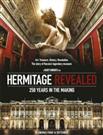|
|
||||
|
|
by Donald Levit  High art is a tough-to-impossible sell in this country where schools no longer teach it and Jeremiahs lament that kids think Caravaggio hobnobs with Tony Soprano. It is thus most rare cinema conjunction of museum stars that follows Frederick Wiseman’s National Gallery in London with Margy Kinmonth’s Hermitage Revealed in celebration of that St. Petersburg/Petrograd/Leningrad world heritage-included site’s two hundred fiftieth anniversary. Followed by a Q&A with its British documentarian who also served as writer, producer, interviewer and voice talent (with Tom Conti, of Pliny the Elder) and with Director of the State Hermitage Museum Mikhail Piotrovsky, the latter film received its North American première special screening at the New York Solomon R. Guggenheim Museum. The filmmaker remarked that the eighty-three minutes is playing to near capacity audiences in the U.K., where a cut will go to BBC, and that it is currently showing in thirty-odd countries, with perhaps future DVD release. Three years in the making because financing was hard to come by, it is, she says, more a “cinema film than a TV film.” She is right, for Maxim Tarasjugin’s camera’s caressing paintings, statuary, jewelry, furniture, carriages, porcelains, tapestry, armor and weaponry, and interior and exterior architecture, will lose much on the small screen. On the other hand, and despite her disclaimer, it is art house and not the type of work to attract commercial success, distribution or general audiences and thus is better suited for PBS this side of the Atlantic. St. Petersburg’s Russian Museum in fact has on display the largest collection of national art. But that “on display” is key because, huge as are its two thousand rooms in five linked buildings including the baroque/rococo ex-royal residence Winter Palace (with its hundred seventeen staircases), the vast majority of the over three million pieces does not fit in and must be consigned to a mile and more of vitrine corridor in suburban Staraya Derevnya. Some other delights, for example various jewels from Fabergé workshops, are only exhibited temporarily. Viewer-friendly titles identify works on-screen, and the Edmund Jolliffe score is appropriate to mood and not just de rigueur window dressing. Focus is not so much on objets d’art per se as on the development, historical and cultural significance and personality of this almost living organism, a city-within-a-city unit unto itself with inhabitants feline mousers as well as human. Although his work has devolved into much politics for funds, Dr. Piotrovsky is himself our genial guide. The son of previous archaeologist director Boris P., he is unwisely pictured too often as a child in shorts roaming these buildings where he had indeed taken his first steps. Turbulent history is traced from the beginning, the 1764 founding by avid and prescient collector Catherine II the Great, who added to the acquisitions and building projects of Peter the Great. Curators receive little enough in the way of salary but are dedicated, lunch with guards and officials below stairs, have their funerals celebrated in the director’s office, and introduce each his/her special collection to the camera. A hundred of their number perished in the 1941-44 siege of Leningrad, and archival footage has them digging in Gulag prison camps during Stalin-era purges. A snip from Eisenstein’s 1928 October/Oktober 1917 (whose famous storming never really occurred) serves as “re-creation,” and historical footage covers the hurried but loving packing up and shipping away as much as possible of the contents during the thousand-day siege. Among moving anecdotes recounted is that of wartime Red Army troops “seeing” empty-frame paintings described by curator guides. Through flood and 1837 fire; through European, civil, world and cold war; through revolution and regicide, purges and penury, national collapse and global controversy over provenance and ownership of art and artifacts, this iconic museum that is more than a museum has survived to link past with present with future (a Hermitage Barcelona projected for ribbon-cutting sometime next year). An annual three million speeded-up time-lapse tourists in the galleries take up too much footage, but otherwise, within its limited minutes, Hermitage Revealed brings a world of treasures and context to those interested in the historical and high culture increasingly on the defensive. Hermitage Revealed is currently screening in select U.S. movie theaters (list here) as part of this special Alternative Content initiative which is a joint venture between Arts Alliance Distribution to bring live theater and cultural events to movie theaters throughout the U.S. (Released by Arts Alliance; not rated by MPAA.) |
||
|
© 2025 - ReelTalk Movie Reviews Website designed by Dot Pitch Studios, LLC |



